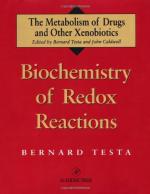|
This section contains 552 words (approx. 2 pages at 300 words per page) |

|
An oxidation-reduction or redox reaction is transformation involving electron transfer. It consists of a half reaction in which a substance loses an electron or electrons (oxidation) and another half reaction in which a substance gains an electron or electrons (reduction).
The substance that gains electrons is the oxidizing agent, while the substance that gives up electrons is the reducing agent. Adding the two half equations algebraically and eliminating the free electrons gives the complete oxidation-reduction equation. This equation, however, is not an assurance that the reaction will proceed spontaneously as written. One way to know the direction of the reaction is to determine the value of the standard free energy change, ΔG0, and then to calculate the free energy change, ΔG, for the complete redox reaction. If the resulting value of ΔG is negative, the reaction will proceed spontaneously as written. If ΔG is...
|
This section contains 552 words (approx. 2 pages at 300 words per page) |

|


